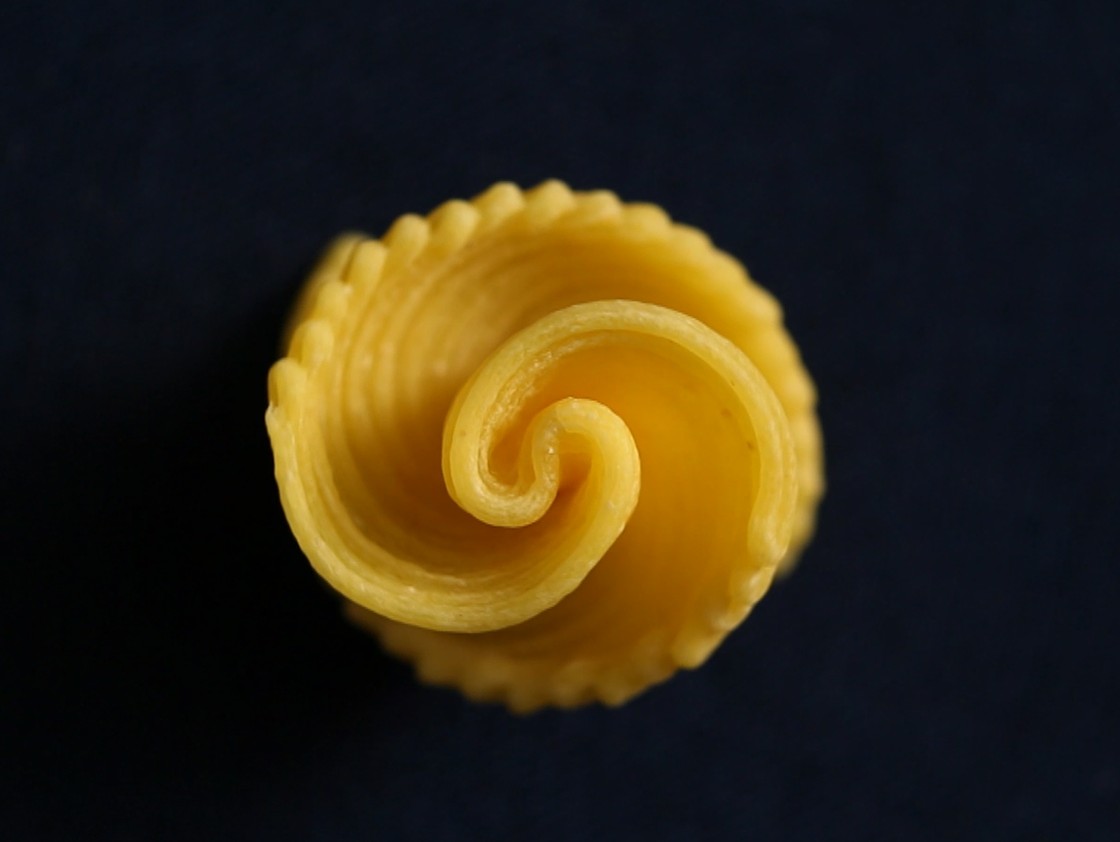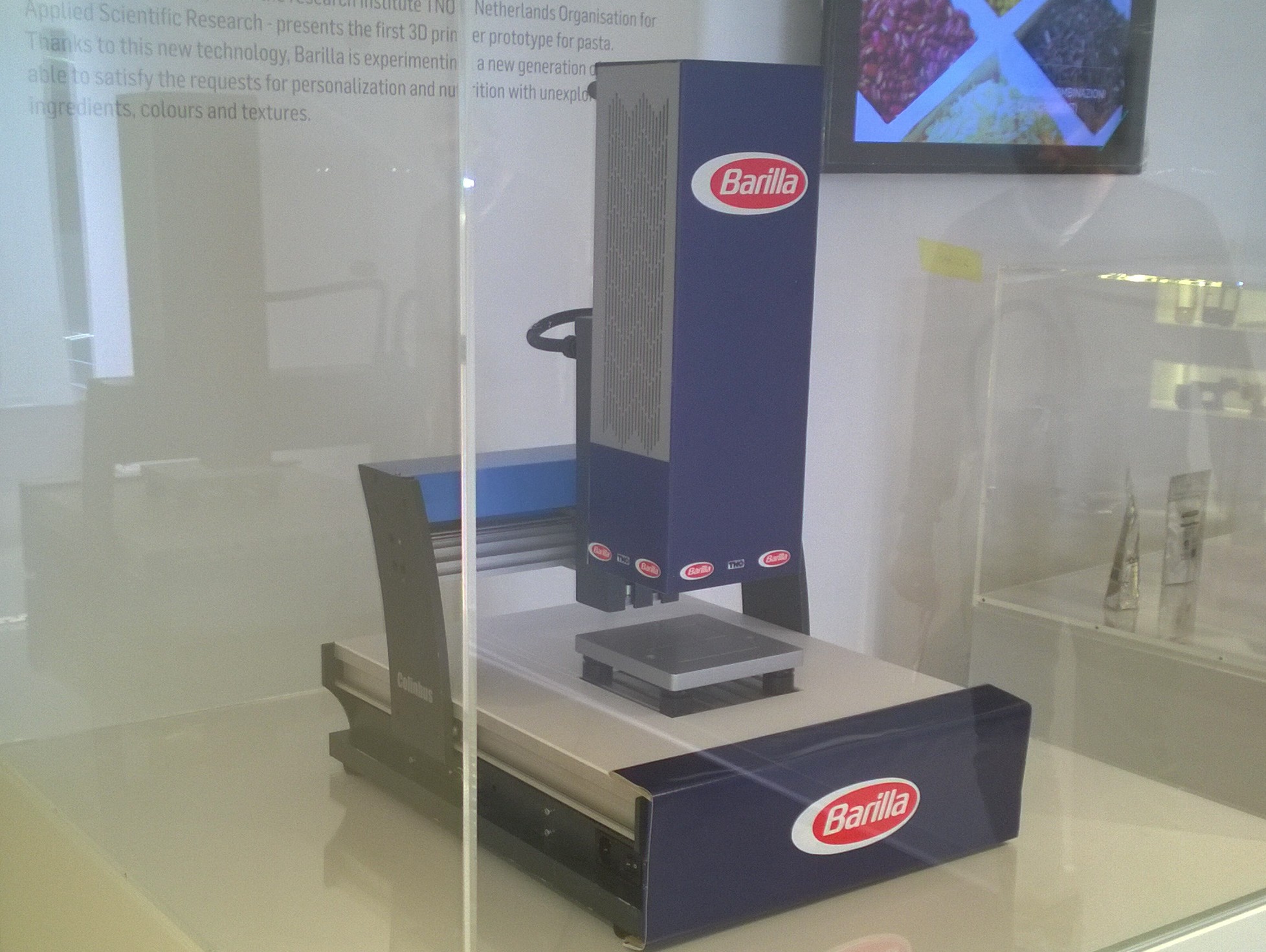
Picture the scene: you go into a restaurant, possibly with the CAD files for your self-designed pasta which you give to the chef. A little later your personal pasta is served to you on a plate, accompanied by a delicious sauce of course. Science fiction, perhaps? Not any more!
Last year we reported on the various techniques, possibilities and opportunities related to 3D food printing. “The techniques are available. Now it’s down to the industry,” the article concluded. Now, just a year later, it’s high time for an update, because Barilla, a traditional family-owned company and one of Italy’s leading pasta producers, is presenting the very first 3D pasta printer at the World Expo in Milan – and that’s not the only example.
Barilla’s 3D pasta printer was designed in collaboration with a team of scientists from TNO and is capable of making 4 pieces in around 90 seconds. The team is working hard to speed up the process. Daniël van der Linden from TNO is closely involved with the project. “This presentation is not only a way for Barilla to show that it’s a world-leading pioneer, but also to gain feedback from the market. Is there interest in a device like this? Does the professional world see possibilities and are they prepared to invest in them? In the meantime, we’ve also started exploring how Barilla could use this machine commercially in a way that fits with Barilla’s image and customer expectations of the company. Barilla is known for its superior quality so there’s no room for compromise in that respect. Which other, completely new business models could be conceivable? We help companies to gain insight into where the chances and opportunities lie, and what the limitations are.”
'3D food printing: An unstoppable development'
So far, 3D food printing has been used mainly for fun or exclusivity. Katjes, a German confectionery manufacturer, has recently introduced the Magic Candy Factory, for instance. This printer contains templates with quick-setting wine-gum ingredients. Thanks to a specially developed computer program, consumers can choose the shape, taste and colour of the sweets for themselves. The company only has one printer for now, but the longer-term aim is to install the printers in department stores and theme parks, in a glass display case, so that consumers can see the entire production process. It takes around 10 minutes to print a candy weighing approximately 30g. A single candy costs five euros – that’s not cheap but nor is it prohibitive. Meanwhile, the company called Choc Edge recently launched the first commercial 3D chocolate printers, and 3DSystems and ChocaByte are also planning to introduce a similar printer in the near future. The ‘PancakeBot’, an initiative of the US company called StoreBound from New York, enables people to personalise pancakes. “We’re noticing that these printers are mainly based on the FDM technique,” says Daniël. “We’re also working to develop other printers: ones that allow us to influence the structure of food and can do more than simply reproduce existing textures.”
“We now know that it’s possible to print things like pasta, confectionery and chocolate, etc. That wasn’t feasible 3 years ago. But the 3D printer mustn’t become a device that falls out of favour after a while because it can only do one thing,” believes Daniël. “At TNO, we’ve made good progress over the past year on other 3D printers and on striking the right balance between food formulation and printing technology. We’ve recently developed a kind of toolbox which enables us to find the right match much more quickly. It’s no longer an endless cycle of trial and error. The printer of the future must be able to make multiple products with a variety of structures and textures. I’m currently setting up a consortium to support the development of that technique, and we will be making a start in a month’s time. If companies want to know more about it or want to join in, they’re welcome to contact us.”
“The major food companies have been closely monitoring the developments for years, but most of them took a wait-and-see approach. We’re seeing a shift in that attitude now that companies are actually stepping forward with examples. We can play a role in bringing people together,” says Daniël. “We also involve scientists from other TNO departments in our discussions: food technologists who are specialised in formulations, fats, proteins; equipment builders, i.e. experts in processes, steel, nuts and bolts; and people from the Strategic Business Analysis department who conduct research into what companies want, what adds value for them and which strategy suits them best. So it’s no longer just about the technology, but also about the business cases and business models. On the one hand we’re focusing on technical innovation, the ICT requirements, the accessories such as printer cartridges and apps, and on the other we’re seriously thinking about the marketing opportunities.”

Daniël is visibly proud of being able to contribute to this development: “It’s fantastic that we, TNO, can help the Netherlands to take a leading role in this development because it’s definitely an unstoppable one. The ability to print steaks to feed the whole world is still a long way off, but I do see a lot of realistic possibilities, such as for applications, ICT and printers to personalise food for events for instance. One thing’s for sure: existing chain infrastructures will change, so the entire chain will have to pull together.”
Source: TNO